1 Day Badaling Great Wall Volunteer Repair
- Overview
- Itinerary
- Reviews
Tour Overview
This private day tour of Great Wall Volunteer Repair Program is suitable for those culture lovers, family travelers with kids, and overseas student study groups. After being transferred to the Badaling Remnant Great Wall Scenic Area, professional restorers and our guide will first accompany you to carry out some basic work of constructing the Great Wall in a specific area, such as laying bricks, building walls, and paving roads. During the process, feel the hard-won nature of this ancient defensive system and understand the significance and difficulty of its protection and restoration. Also, seize the opportunity to freely hike on the Great Wall to enjoy its majesty and surrounding mesmerizing landscapes, as well as explore other meaningful historical sites in the scenic area, including the Ancient Brick Kiln Complex and Quarry Ruins. All our itineraries are customizable, and welcome to call us for consultation at any time. ... Read more
Trip Highlights
- Personalized private tour tailored to your own schedule and interests.
- English-speaking private guide, air-conditioned private car with experienced driver.
- Harvest a unique Great Wall repairing experience with your own hands.
- Admire ancient Badaling Remnant Great Wall and surrounding historical remains.
Morning Pick-up from Hotel in Downtown Beijing
Today, let’s embark on a volunteer journey from Beijing to Badaling Remnant Great Wall Scenic Area to ‘repair’ the Great Wall, which will bring you a far more interesting and memorable experience than other normal sightseeing. In the morning, at the time agreed upon with you the day before, our guide and driver will show up punctually at your self-booked hotel’s lobby, and then take you to the destination in a comfortable vehicle for about 1.5 hours. En route, the guide will introduce you to the details of today’s schedule and the background information on this section of the Great Wall.
● How Much do You Know about the Badaling Remnant Great Wall?
It is also known as the Shixiaguan Great Wall and is the southwestern extension of the widely known Badaling Great Wall, which is located 5 kilometers (3 miles) away. It was right here that a famous general, Li Zicheng, once led a peasant uprising to successfully break through into Beijing and overthrow the Ming Dynasty (1368 - 1644) on the advice of a local elder. This section has not undergone large-scale restoration, with the dilapidated and collapsed walls and watchtowers, as well as overgrown weeds, showing the historical vicissitudes and endless ancient appeal of the Great Wall of China.
► Kind Note:
To be ready for the repair work and the following free exploration of the scenic area, you are advised to wear comfortable casual clothes and sports shoes. Besides, it is also very necessary to pack a sunhat, sunglasses, and sunscreen on sunny days with you since you can hardly find a shade on the Wall.
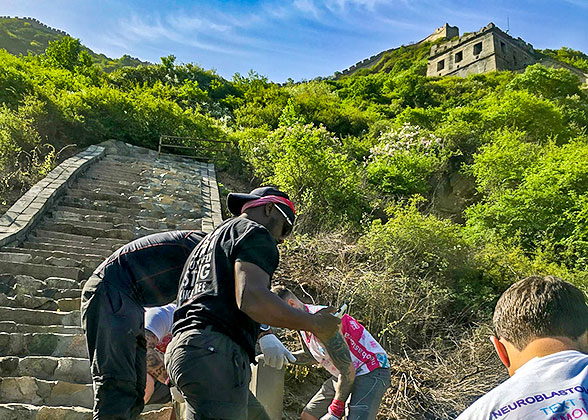
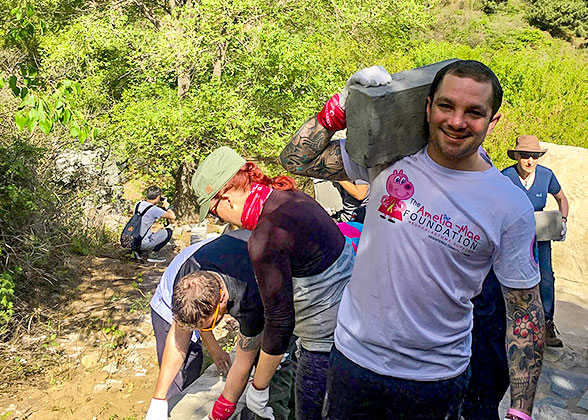
● How Much do You Know about the Badaling Remnant Great Wall?
It is also known as the Shixiaguan Great Wall and is the southwestern extension of the widely known Badaling Great Wall, which is located 5 kilometers (3 miles) away. It was right here that a famous general, Li Zicheng, once led a peasant uprising to successfully break through into Beijing and overthrow the Ming Dynasty (1368 - 1644) on the advice of a local elder. This section has not undergone large-scale restoration, with the dilapidated and collapsed walls and watchtowers, as well as overgrown weeds, showing the historical vicissitudes and endless ancient appeal of the Great Wall of China.
► Kind Note:
To be ready for the repair work and the following free exploration of the scenic area, you are advised to wear comfortable casual clothes and sports shoes. Besides, it is also very necessary to pack a sunhat, sunglasses, and sunscreen on sunny days with you since you can hardly find a shade on the Wall.

Pave the Trail of the Great Wall

Repair the Wall by hands
Repair Experience on the Badaling Renament Great Wall
Upon arrival, you will be warmly received by the staff of the scenic area. Subsequently, they will brief you on the detailed work, the do's and don'ts of the Great Wall repair volunteer program, and meanwhile distribute tools used for repairing, such as buckets, brushes, gloves, and shovels. After that, under the guidance of the restoration experts and the guide, get real insights into how the Great Wall is repaired and restored by joining hands-on activities, including moving bricks, building a wall, and paving the ground. The whole volunteer work may last about 1 to 1.5 hours.
As you wheeze up the mountain with bricks on your shoulder, you may sigh at how hard it was for laborers to do this work 2,000 years ago. The Great Wall was usually built on the ridges without real roads, and there were even bottomless chasms on both sides in some parts. At that time, the toilers could only transport materials to the ridge by their own strength, going back and forth again and again. As early as after Qin Shi Huang, the first emperor in China’s history, unified the six states, he still followed the ideas of militarist Shang Yang from the Warring States Period (476 - 221 BC) to govern the country, that is, to continue to exhaust people and money to engage in expansionary wars, which inevitably included the construction of the Great Wall. It can be seen that the birth of this miracle project is inseparable from the people’s hard work all along.
Afterward, experience using cement mortar mixed with lime to closely bond the large bricks carried up together, and build a wall like the skilled craftsmen thousands of years ago. By the way, it is interesting to know that as the restoration principle is to retain the “original flavor’ of the Great Wall to the greatest extent, the bricks used are all old or new ones custom-made according to ancient methods. Also, it is said that glutinous rice paste was used to enhance the adhesive strength between bricks when building walls in the past. Perhaps the Great Wall has survived the war damages to this day, and this natural ‘glue’ has also played a significant role!
In addition, follow the restoration workers to clear the weeds and turn the soil, preparing for the next activity - paving the trails. When squatting on the ground to stabilize the long bricks using the mortar technique, in the trance of the sun's halo, you may feel as if you have traveled through time and space and returned to ancient times.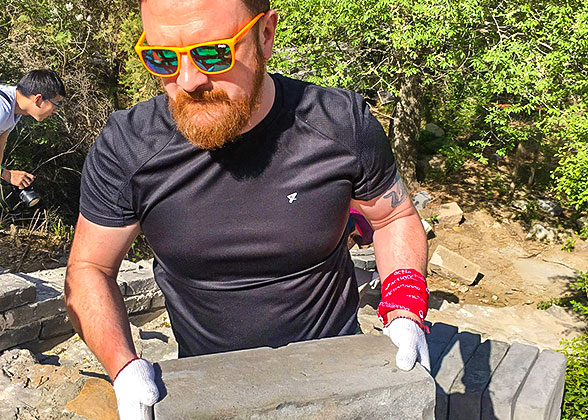
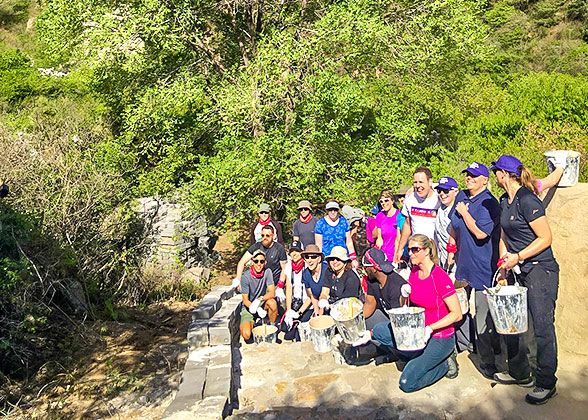 ● Why was the Great Wall Volunteer Repair Program Initiated?
● Why was the Great Wall Volunteer Repair Program Initiated?
The Great Wall is more than an icon of China, but is an enduringly man-made wonder in the world. Standing before any section of the Great Wall decades years ago, apart from witnessing its grandeur, one might have also noticed that some parts of the seemingly solid wall had cracked or even collapsed due to wind and rain erosion. It is said that in the 20th century, there were nearby villagers who not only collected Chinese herbs or scorpions on and around the Great Wall, but also dug up bricks from watchtowers and brought back to build their own houses. These natural or human activities indeed caused considerable damage to the Great Wall, so to prolong the life of this non-renewable cultural heritage of China and eliminate potential safety hazards for tourists, the restoration work need to be carried out.
As you wheeze up the mountain with bricks on your shoulder, you may sigh at how hard it was for laborers to do this work 2,000 years ago. The Great Wall was usually built on the ridges without real roads, and there were even bottomless chasms on both sides in some parts. At that time, the toilers could only transport materials to the ridge by their own strength, going back and forth again and again. As early as after Qin Shi Huang, the first emperor in China’s history, unified the six states, he still followed the ideas of militarist Shang Yang from the Warring States Period (476 - 221 BC) to govern the country, that is, to continue to exhaust people and money to engage in expansionary wars, which inevitably included the construction of the Great Wall. It can be seen that the birth of this miracle project is inseparable from the people’s hard work all along.
Afterward, experience using cement mortar mixed with lime to closely bond the large bricks carried up together, and build a wall like the skilled craftsmen thousands of years ago. By the way, it is interesting to know that as the restoration principle is to retain the “original flavor’ of the Great Wall to the greatest extent, the bricks used are all old or new ones custom-made according to ancient methods. Also, it is said that glutinous rice paste was used to enhance the adhesive strength between bricks when building walls in the past. Perhaps the Great Wall has survived the war damages to this day, and this natural ‘glue’ has also played a significant role!
In addition, follow the restoration workers to clear the weeds and turn the soil, preparing for the next activity - paving the trails. When squatting on the ground to stabilize the long bricks using the mortar technique, in the trance of the sun's halo, you may feel as if you have traveled through time and space and returned to ancient times.

Carry the Bricks

Volunteers of the Repair Program
The Great Wall is more than an icon of China, but is an enduringly man-made wonder in the world. Standing before any section of the Great Wall decades years ago, apart from witnessing its grandeur, one might have also noticed that some parts of the seemingly solid wall had cracked or even collapsed due to wind and rain erosion. It is said that in the 20th century, there were nearby villagers who not only collected Chinese herbs or scorpions on and around the Great Wall, but also dug up bricks from watchtowers and brought back to build their own houses. These natural or human activities indeed caused considerable damage to the Great Wall, so to prolong the life of this non-renewable cultural heritage of China and eliminate potential safety hazards for tourists, the restoration work need to be carried out.
Leisurely Hike around the Great Wall
In the afternoon, you’ll be free to enjoy a fantastic time in the scenic area. Firstly, hiking on the original Badaling Remnant Great Wall itself is an unmissable activity. The section available to the public is approximately 2 kilometers (1.2 miles) long and has 4 watchtowers. Trekking from the 1st watchtower to the 3rd won’t be too strenuous for you as the terrain is relatively flat. Moreover, iron handrails on both sides of the Wall can facilitate your climbing. But the part between the 3rd and the 4th will become particularly steep, with some steps that can only hold half a foot, which requires you to use both hands and feet to take on the challenge. Retrace your steps whenever you feel tired. Also, some well-preserved historical sites at the foot of the Great Wall deserve your visit, such as the Ancient Brick Kiln Complex and Quarry Ruins, which were places for baking bricks and processing granite for wall construction in ancient times. Establishing them here can save labor and time, which right indicates the ingenuity of the ancient craftsmen. If you come in April, sightsee the Apricot Blossom Valley as well, which is covered with a hundred acres of apricot trees, presenting you with a breathtaking view of a sea of pink and white flowers.
► Tip: Lunch is not included. It is strongly recommended that you eat a substantial breakfast at your hotel this morning and pack some easily carried snacks like bread or burgers and a few bottles of drinks to replenish energy, as you’ll find no restaurants in this lesser-known scenic area.
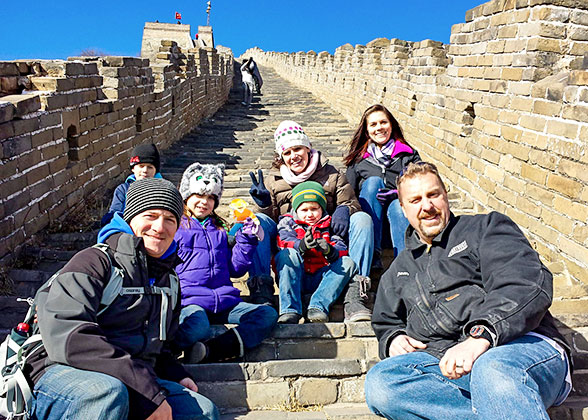
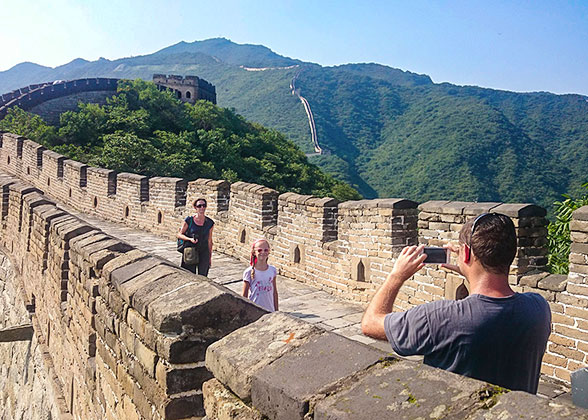
► Tip: Lunch is not included. It is strongly recommended that you eat a substantial breakfast at your hotel this morning and pack some easily carried snacks like bread or burgers and a few bottles of drinks to replenish energy, as you’ll find no restaurants in this lesser-known scenic area.

Enjoy Leisurely Hike on Great Wall after Repair Experience

Our Guests on Badaling Great Wall
Hotel Drop-off
At the end of this day trip from Beijing to Badaling Remnant Great Wall, you will be escorted back to your downtown hotel. Hope you had a great day with us! Plan to stay in Beijing for a few more days? Then consider visiting the city highlights like the Forbidden City, Temple of Heaven, and Summer Palace, all boasting China’s glorious history of the Ming and Qing Dynasties (1368 - 1911). We are always available online, and welcome to contact us to customize an exclusive trip for you.
Itineraries you may also like:
 Beijing Mini Group Day Tour to Tiananmen Square, Forbidden City, Mutianyu Great Wall, and Hutong from USD85
Beijing Mini Group Day Tour to Tiananmen Square, Forbidden City, Mutianyu Great Wall, and Hutong from USD85 2 Days Beijing Mini Group to Visit Great Wall, Forbidden City, Temple of Heaven, Summer Palace, and more from USD169
2 Days Beijing Mini Group to Visit Great Wall, Forbidden City, Temple of Heaven, Summer Palace, and more from USD169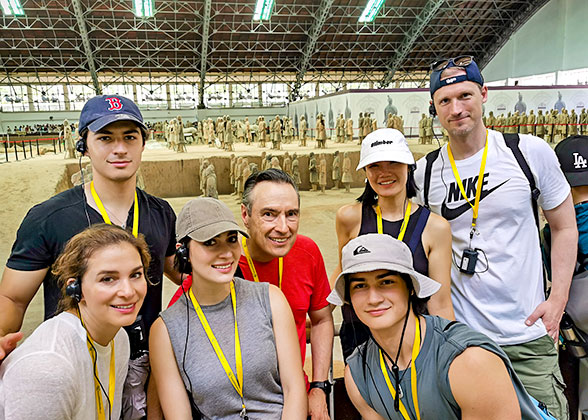 Xi’an Mini Group Day Tour to Terracotta Army, Giant Wild Goose Pagoda, City Wall, and Muslim Bazaar from USD79
Xi’an Mini Group Day Tour to Terracotta Army, Giant Wild Goose Pagoda, City Wall, and Muslim Bazaar from USD79
